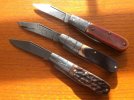This is really an interesting thread. You'd think a mechanical device as simple as a pocket knife would be easy to get to work perfectly every time one dropped off the end of the production line, but apparently they aren't that easy. One thing that bugs me a little bit about the use of "blade play" or "wobble" to describe side to side movement of folder blades is the fact that rarely is that movement quantified in any way during the discussion. maybe it can't or shouldn't be quantified since some believe it is unacceptable. If the liners are hard against the tang, there won't be any play but the action will be lazy and you won't have crisp movement or snap, walk n talk, etc of the blade. There has to be SOME RELIEF in the pivot area or the knife just won't work like we expect them to. If the spring is too weak in a knife, chances are it's going to be more difficult for the maker to achieve a play-free joint. The spring load needs to overcome the friction of the liners pressing against the spring and tang to achieve a play-free joint. Make the spring load too high, broken springs can occur, and have. Make them too weak and they're slackening the joints to get good blade action. This can be where "excessive play" is introduced. I'm of the opinion that some play is necessary and that the ideal situation is that blade play is darn near imperceptable. However, I would rather have a knife with "slight play" that worked rather than one that was too tight and sluggish? As some have said, a little play doesn't hurt the function of the knife. I wish I knew of a way to quantify acceptable blade play but I think every knife is different when it gets put together. In this thread some have said it doesn't bother them while others have said any play is unacceptable so we aren't going to agree on a correct answer. All I know is, whatever gives bouancy to your particular water craft is whut ya got right there. I particularly enjoyed this comment by Knifeswapper: You try this one time and you will probably never complain again, as it will become obvious what a time-consuming art getting this perfect joint requires. Boy is that the truth! I'll go one further and say, try putting together a slip joint kit or better yet, make one from scratch and tell us how that goes. :thumbup: PS. I thought you all might like to see how to introduce blade play into your very own slip joint. If it seems to be going a little slow....use a bigger hammer. This is actually one way to slacken the liner pressure against the tang.


